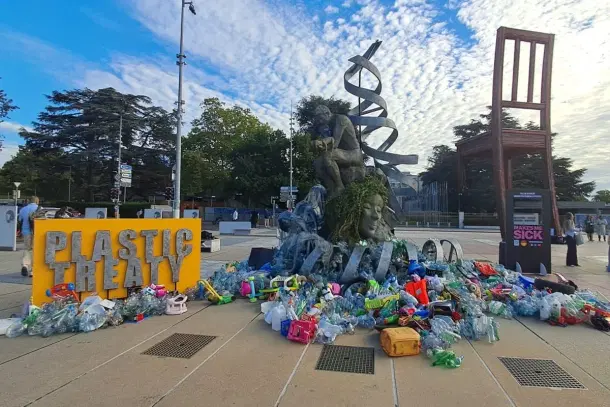Economy
Can The World Seal A Plastics Treaty And Why Does India Matter?
Amit Mishra
Aug 14, 2025, 12:29 PM | Updated 12:29 PM IST
Save & read from anywhere!
Bookmark stories for easy access on any device or the Swarajya app.


It was supposed to be a miracle material.
When plastic first entered our lives, it promised transformation: light enough to replace heavy metals, strong enough to last for years, cheap enough to make products accessible to millions. Humanity had found its perfect material.
In just two decades, production has exploded. The world churned out 234 million tonnes of plastic in 2000; by 2019, that figure had nearly doubled to 460 million tonnes. Asia now accounts for nearly half of global output, followed by North America (19 per cent) and Europe (15 per cent). The OECD warns that by 2040, production could swell to 700 million tonnes annually.
But perfection came with a price. The very traits that made plastic a triumph (durability, versatility, resistance to decay) are now its curse.
Plastic doesn't vanish; it lingers for decades, even centuries, breaking into microplastics that infiltrate soil, waterways, and even the air we breathe. Depending on the type, it can take anywhere from 20 to 500 years to decompose. To date, less than 10 per cent of all the plastic ever made has been recycled, according to a 2023 Lancet study.
The scale of pollution is staggering. Each year, between 19 and 23 million tonnes of plastic leak into lakes, rivers, and oceans: equivalent to 2,000 garbage trucks' worth of plastic dumped into our waters every single day.
Without drastic intervention, global plastic waste is set to triple by 2060, hitting 1.7 billion tonnes and inflicting an estimated $281 trillion in cumulative damage, warn UNEP and the OECD.
The climate cost is equally grim. In 2020, plastic was responsible for 3.6 per cent of global greenhouse gas emissions, with 90 per cent of that coming from its production, powered largely by fossil fuels. The rest came from waste management and disposal. If business as usual continues, the Lawrence Berkeley National Laboratory predicts emissions from production alone could climb by 20 per cent by 2050.
Given such dire warnings, one might assume the world has acted decisively. The reality is far more frustrating.
For decades, the politics and economics of plastic have blocked real progress. At the heart of the problem is its umbilical link to the fossil fuel industry. For petrochemical giants (many based in oil-exporting nations like Saudi Arabia, Russia, and Iran) plastic is not an environmental threat to be phased out but a vital growth market, especially as clean energy threatens to shrink oil demand.
These producers, along with supportive political allies, have consistently resisted calls for binding limits on virgin plastic production. Instead, they promote voluntary, downstream measures that focus on waste management, effectively shifting responsibility to consumers and municipalities rather than producers.
The result? A problem that grows bigger, more complex, and more expensive with every passing year.
A Fragile Breakthrough
Yet, there is a glimmer of hope.
In 2022, the UN Environment Assembly adopted a historic resolution to create the world's first legally binding treaty to end plastic pollution, including in the oceans.
To deliver on that vision, it set up an International Negotiating Committee (INC) tasked with drafting and finalising the treaty, formally known as the International Legally Binding Instrument (ILBI).
Since its start in 2022, the INC has met five times, most recently in Busan, South Korea, in 2024: a meeting that was meant to be the last and end with a treaty adoption.
The fifth and final session has been split into two parts: INC-5.1, held from 25 November to 1 December 2024 in Busan, and INC-5.2, currently underway in Geneva, Switzerland. Around 180 countries are at the table, attempting to hammer out a global pact that could reshape humanity's relationship with plastic.
But progress has been slow, and patience is wearing thin. Halfway through what is supposed to be the final round of talks, consensus remains elusive. On Saturday (9 August), five days into the Geneva talks, which end 14 August, the INC Chair, Luis Vayas Valdivieso, offered a blunt assessment:
"The progress that we have made is not sufficient. We have had two-and-a-half years of opportunities for delegations to make proposals and express their views... There is no more time to continue having positions already stated."
In Geneva, Hopes Fade
At its core, the treaty aims to address the "full life cycle" of plastic: an approach that goes far beyond cleaning up waste once it's made.
It calls for a fundamental rethink of how plastics are designed, produced, and consumed, challenging the petrochemical industry at its roots. It also seeks to set up financing mechanisms so developing countries can meet these goals without crippling their economies.
But there's a catch: no one can agree on how bold this treaty should be.
Some nations are pushing for strong, legally binding global rules, including production caps and chemical bans, while others favour a looser framework, letting each country set its own goals and timelines.
The depth of division is visible in the proliferation of "brackets" in the draft text: all countries who disagree with even a single line put forth their own views in ‘brackets’. At the start of the Geneva talks on 4 August, there were around 300 such contested sections. By 9 August, that number had ballooned to a staggering 1,500.
Two clear camps have emerged over four sessions of negotiations. On one side is the High Ambition Coalition (HAC), led by Norway and Rwanda and joined by nearly 80 nations, including EU members, many African states, Australia, and Pacific Island nations.
On the other side is a smaller, informal bloc of Like-Minded Countries (LMC): Saudi Arabia, Iran, Russia, China, Bahrain, Kuwait, Cuba, and others, largely petrochemical powerhouses with a shared interest in keeping production caps off the table.
The split between them could not be sharper. The HAC argues that cutting plastic production is essential to tackling pollution. The LMC rejects any restrictions on the production of plastics or certain chemicals used in their manufacture: essentially the diametric opposite of the 'High Ambition Coalition'.
The stakes are enormous. A July analysis by the International Energy Agency found that Asia dominates the global trade in primary plastic polymers: ethylene, propylene, styrene, and derivatives like polypropylene and polyethylene. The U.S. is the top exporter in North America, while Europe plays a dual role as both importer and exporter. Africa and South America barely register in trade volumes. In such a globalised market, production caps could have far-reaching consequences for petrochemical economies.
The United States, conspicuously absent from both blocs, talks up its support for a "strong treaty" but stops short of endorsing production cuts. In late July 2025, the Trump administration went further, quietly circulating a memo to other delegations urging them to strike any limits on production or chemicals and to remove "full life-cycle" language altogether. That language would have forced producers to take responsibility for plastics from design to disposal.
For the record, under former President Joe Biden's administration, the U.S. had supported the treaty addressing supply and production.
Meanwhile, the Geneva talks have been shadowed by another force: industry influence. According to watchdog groups, at least 234 corporate lobbyists have attended the resumed fifth session: more than the number of scientists and Indigenous representatives combined. For environmental campaigners, this imbalance is a red flag, a sign that powerful industry interests could yet water down the world's best chance at a truly transformative plastics treaty.
The Tightrope Walk
Against the backdrop of a tense global debate, India's stance at the Geneva plastics treaty talks has come under intense scrutiny. On the eve of the negotiations, DMK MP Thamizhachi Thangapandian presented Environment Minister Bhupendra Yadav with a memorandum urging India to take a "lead role" in securing a robust, time-bound, and enforceable global agreement.
On Saturday, India declared its alignment with the LMC coalition. Under current rules, treaty provisions cannot pass by a simple majority: near-unanimous support is required, making consensus both essential and elusive.
India's support for the LMC mirrors the position taken by the Plastics Manufacturers Association, an industry lobby, in a submission to INC Chair Ambassador Luis Vayas Valdivieso on 5 August. "We believe that any cap on the production of primary polymers will do more harm than good as its growing needs in a multitude of areas cannot be met with other materials in the quantities needed," says the submission.
India's role in the plastics treaty debate is not just a function of its scale as one of the world's largest producers and consumers of plastic: it is also driven by the sheer weight of its pollution footprint.
A September study in Nature found that India is responsible for a staggering one-fifth of global plastic pollution, releasing 9.3 million tonnes annually. That is nearly three times more than the next worst offenders: Nigeria at 3.5 million tonnes, Indonesia at 3.4 million tonnes, and China at 2.8 million tonnes.
Equally crucial is India's unique position straddling the divide between developed and developing nations: a position it has cultivated over decades. At home, it has demonstrated some willingness to act, banning 19 single-use plastic items in 2022, from cutlery and straws to cigarette packs, while states like Tamil Nadu have pioneered community-led waste management and reusable packaging initiatives that create green jobs.
Yet its economy still leans heavily on industries that depend on plastic for packaging, manufacturing, and export competitiveness. This makes its negotiating stance a high-wire act. Push too hard for binding production caps, and it risks sparking resistance from domestic industry and certain trade partners.
Align too closely with those opposing ambitious measures, and it could squander its moral authority as a champion amongst emerging economies. That is why the Geneva moment is so critical: India's choices here could tip the scales in either direction.
Road Ahead
Whether the Geneva talks will produce a landmark treaty to curb the spiralling plastic pollution crisis remains uncertain. In the most hopeful scenario, observers want more than lofty rhetoric: they want a genuinely transformative pact.
Some form of agreement is virtually assured; after years of negotiations, an outright collapse is politically inconceivable. The real question is its substance. Will it set hard caps on plastic production, enact sweeping chemical bans, and secure real financing for poorer nations? Or will it settle for the safer path of voluntary pledges, sidestepping the deep structural changes the crisis demands?
The parallels with the Paris Agreement on climate change are hard to ignore. When that deal was signed in 2015, it was celebrated as a milestone in global cooperation. Yet in the years since, emissions have continued to rise, and much of the agreement's progress has depended on voluntary national commitments that are not legally enforceable. A plastics treaty that follows the same path (grand declarations without binding mechanisms) risks repeating those mistakes.
Still, there are grounds for cautious optimism. Public awareness is at an all-time high. Civil society and grassroots movements have mobilised across continents, from coastal clean-ups in the Philippines to waste-free city initiatives in Europe.
In Geneva, the dry language of technical negotiations is being offset by vivid reminders of what is at stake. Outside the United Nations Office, a six-metre-tall sculpture by Benjamin Von Wong, The Thinker’s Burden, shows a world slowly drowning in plastic.
Covered in living vines, the sculpture will be slowly engulfed by a mounting wave of plastic waste throughout the negotiations: a visual metaphor for the toxic legacy being passed on to future generations.
The message is blunt: plastic pollution is not an abstract policy challenge, but a daily reality for millions.





